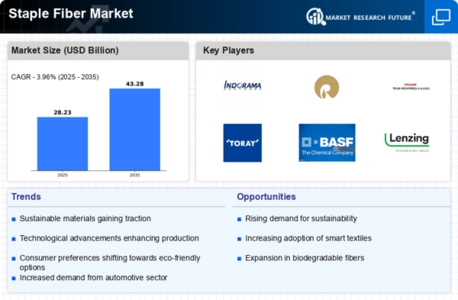Diverse Fiber Demand
The Staple Fiber Market is characterized by diverse fiber demand, driven by various end-use applications such as apparel, home textiles, and industrial products. The apparel segment remains a dominant force, accounting for a substantial share of the market. In 2025, the demand for staple fibers in the apparel sector is expected to exceed several million tons, reflecting changing consumer preferences for comfort and functionality. Additionally, the rise of athleisure and sustainable fashion trends is further propelling the demand for specific fibers like polyester and organic cotton. Moreover, the industrial applications of staple fibers, including automotive and construction materials, are also expanding, indicating a broadening scope for market players. This diverse demand landscape presents both challenges and opportunities for the Staple Fiber Market, as companies must adapt to varying consumer needs and market dynamics.
Sustainability Initiatives
The Staple Fiber Market is increasingly influenced by sustainability initiatives, as consumers and manufacturers alike prioritize eco-friendly practices. The demand for biodegradable and recyclable fibers is on the rise, with a notable shift towards natural fibers such as cotton and wool. This trend is driven by heightened awareness of environmental issues and the need for sustainable production methods. In 2025, the market for sustainable fibers is projected to grow significantly, with estimates suggesting a compound annual growth rate of over 10%. Companies are investing in sustainable sourcing and production techniques, which not only cater to consumer preferences but also comply with stringent regulations aimed at reducing environmental impact. As a result, the Staple Fiber Market is likely to witness a transformation, with sustainability becoming a core component of business strategies.
Technological Advancements
Technological advancements play a pivotal role in shaping the Staple Fiber Market, as innovations in fiber production and processing enhance efficiency and quality. The integration of automation and artificial intelligence in manufacturing processes has led to increased productivity and reduced operational costs. For instance, advancements in spinning technologies have enabled the production of finer and stronger fibers, catering to the evolving demands of the textile industry. Furthermore, the development of smart textiles, which incorporate electronic components into fibers, is gaining traction. This trend is expected to drive market growth, with projections indicating that the market for smart textiles could reach several billion dollars by 2026. Consequently, the Staple Fiber Market is poised for significant evolution, as companies leverage technology to meet consumer expectations and improve their competitive edge.
Economic Growth and Urbanization
Economic growth and urbanization are significant drivers of the Staple Fiber Market, as rising disposable incomes and changing lifestyles lead to increased consumption of textile products. In emerging markets, urbanization is contributing to a burgeoning middle class, which is likely to drive demand for clothing and home textiles. As urban populations grow, the need for affordable and fashionable textiles becomes more pronounced. Reports indicate that the textile and apparel market is expected to reach trillions of dollars by 2026, with staple fibers playing a crucial role in meeting this demand. Furthermore, the expansion of retail channels and e-commerce platforms is facilitating access to a wider range of textile products, thereby stimulating market growth. Consequently, the Staple Fiber Market is positioned to benefit from these economic trends, as consumer spending on textiles continues to rise.
Regulatory Frameworks and Standards
Regulatory frameworks and standards significantly impact the Staple Fiber Market, as governments worldwide implement policies aimed at ensuring product safety and environmental sustainability. Compliance with these regulations is essential for manufacturers, as non-compliance can lead to penalties and loss of market access. In recent years, there has been a push for stricter regulations regarding the use of chemicals in fiber production and the environmental impact of textile waste. This has prompted companies to adopt more sustainable practices and invest in cleaner technologies. The market is likely to see an increase in certifications and standards that promote eco-friendly fibers, which could enhance consumer trust and brand loyalty. As such, the Staple Fiber Market must navigate this evolving regulatory landscape, balancing compliance with innovation to remain competitive.



.webp)
.webp)
.webp)
.webp)
.webp)
.webp)








Leave a Comment